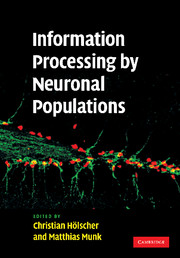Book contents
- Frontmatter
- Contents
- List of contributors
- Part I Introduction
- Part II Organization of neuronal activity in neuronal populations
- Part III Neuronal population information coding and plasticity in specific brain areas
- Part IV Functional integration of different brain areas in information processing and plasticity
- Part V Disturbances of population activity as the basis of schizophrenia
- 16 Neural coordination and psychotic disorganization
- 17 The role of synchronous gamma-band activity in schizophrenia
- Part VI Summary, conclusion, and future targets
- Index
- References
17 - The role of synchronous gamma-band activity in schizophrenia
Published online by Cambridge University Press: 14 August 2009
- Frontmatter
- Contents
- List of contributors
- Part I Introduction
- Part II Organization of neuronal activity in neuronal populations
- Part III Neuronal population information coding and plasticity in specific brain areas
- Part IV Functional integration of different brain areas in information processing and plasticity
- Part V Disturbances of population activity as the basis of schizophrenia
- 16 Neural coordination and psychotic disorganization
- 17 The role of synchronous gamma-band activity in schizophrenia
- Part VI Summary, conclusion, and future targets
- Index
- References
Summary
Introduction
Despite almost 100 years of research into the pathophysiology of schizophrenia, the causes and mechanisms underlying the disease remain poorly understood. For a long time, biological research has focused on finding regionally specific pathophysiological processes in this disorder. In the last decade, however, theories of schizophrenia have laid emphasis upon pathophysiological mechanisms, which involve multiple cortical areas and their coordination. These theories suggest that the core impairment underlying both dysfunctional cognition and the overt symptoms of the disorder arise from a dysfunction in the integration and coordination of distributed neural activity (Andreasen, 1999; Friston, 1999; Phillips and Silverstein, 2003).
Interestingly, a disturbance of integrative processing had already been suggested by Bleuler (1950). He coined the term schizophrenia (“split mind”) to highlight the fragmentation of mental functions. According to him, the fragmentation of mental functions constituted the primary disturbance in schizophrenia that represented a direct manifestation of the organic pathology whilst other symptoms, such as delusions and hallucinations, were accessory or secondary manifestations of the disease process. Contemporary models of schizophrenia for instance by Friston (1999) suggest that the core pathology is an impaired control of (experience-dependent) synaptic plasticity that manifests as abnormal functional integration of neural systems, i.e. dysconnectivity. Andreasen (1999) used “cognitive dysmetria” to refer to the fact that patients with diverse clinical and cognitive deficits share a common underlying deficit in the “timing or sequencing component of mental activity” across multiple brain regions.
- Type
- Chapter
- Information
- Information Processing by Neuronal Populations , pp. 409 - 430Publisher: Cambridge University PressPrint publication year: 2008

